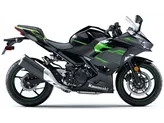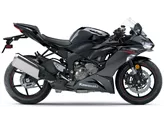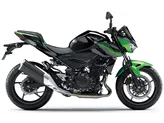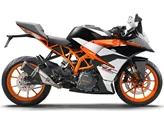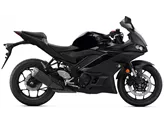Yamaha YZF-R6 2017 vs. Kawasaki Ninja 400 2018

Yamaha YZF-R6 2017

Kawasaki Ninja 400 2018
Overview - Yamaha YZF-R6 2017 vs Kawasaki Ninja 400 2018
When comparing the Yamaha YZF-R6 2017 and the Kawasaki Ninja 400 2018, it is clear that they are both supersport motorcycles with their own unique features and specifications.
Starting with the Yamaha YZF-R6 2017, it boasts a powerful engine with a displacement of 599cc. It has a bore of 67mm and a stroke of 42.5mm, resulting in a high compression ratio of 13. This allows the engine to produce an impressive 124 horsepower and 65.7 Nm of torque. The YZF-R6 has a four-cylinder engine with four valves per cylinder, providing excellent performance. The chassis of the YZF-R6 is made of aluminum and features a Deltabox frame, which contributes to its lightweight and agile handling. The front suspension consists of a telescopic upside-down fork, ensuring a smooth and controlled ride. The YZF-R6 also has dual disc brakes at the front, providing strong and direct stopping power. In terms of dimensions, it has a 120mm wide front tire and a 180mm wide rear tire, both with a diameter of 17 inches. The wheelbase measures 1375mm, and the seat height is 850mm. Additionally, it has a fuel tank capacity of 17 liters.

Yamaha YZF-R6 2017
On the other hand, the Kawasaki Ninja 400 2018 has a smaller engine with a displacement of 399cc. It has a larger bore of 70mm and a stroke of 51.8mm, resulting in a lower compression ratio of 11.5. The engine produces 45 horsepower and 38 Nm of torque, making it less powerful compared to the YZF-R6. The Ninja 400 has a two-cylinder engine with four valves per cylinder, providing a smooth and responsive performance. The chassis of the Ninja 400 is made of steel and features a tubular frame, which contributes to its lightweight and effortless handling. The front suspension consists of a telescopic fork, ensuring a comfortable and controlled ride. Unlike the YZF-R6, the Ninja 400 has a single disc brake at the front. In terms of dimensions, it has a narrower 110mm front tire and a 150mm wide rear tire, both with a diameter of 17 inches. The wheelbase measures 1370mm, and the seat height is 785mm. Additionally, it has a fuel tank capacity of 14 liters. One notable feature of the Ninja 400 is its LED headlights, providing improved visibility.
In terms of strengths, the Yamaha YZF-R6 2017 offers strong and direct brakes, an elegant appearance, an automatic gearbox, good wind protection, precise handling, and high transparency. On the other hand, the Kawasaki Ninja 400 2018 has a chassis suitable for sporty use, reduced weight for effortless handling, a smooth engine response, a relaxed seating position that increases confidence, and LED headlights.

Kawasaki Ninja 400 2018
However, the Yamaha YZF-R6 2017 has some weaknesses, including a radical seating position unsuitable for touring, a stock power output of only 118.4 horsepower, and expensive upgrades. On the other hand, the Kawasaki Ninja 400 2018 has its weaknesses, such as non-adjustable brake and clutch levers and excessive wind noise with the stock windshield for riders over 180cm tall.
In conclusion, while both the Yamaha YZF-R6 2017 and the Kawasaki Ninja 400 2018 are supersport motorcycles, they have distinct differences in terms of engine power, chassis design, and overall features. The YZF-R6 offers a more powerful engine and advanced features, making it suitable for experienced riders looking for high-performance. On the other hand, the Ninja 400 offers a more beginner-friendly option with its lighter weight, smooth engine response, and comfortable seating position. Ultimately, the choice between these two models depends on the rider's preferences, skill level, and intended use.
Technical Specifications Yamaha YZF-R6 2017 compared to Kawasaki Ninja 400 2018
Pros and Cons in comparison
Pros and Cons in comparison
Yamaha YZF-R6 2017

A Yamaha R6 2017 ainda é uma moto superesportiva visual e dinamicamente radical que é uma das melhores e provavelmente a última de seu tipo. O padrão EURO4 custa aos 599 cúbicos em linha de quatro cilindros com válvulas de titânio um total de 11 cv em comparação com o modelo 2007/2008. A Yamaha está claramente visando hobby, pilotos amadores e profissionais que não se importam com o desempenho padrão de qualquer maneira. Com mais de 50 acessórios, a R6 pode ser actualizada de acordo com as necessidades e o orçamento. No entanto, todos devem estar cientes de que isso pode custar muito dinheiro.
Kawasaki Ninja 400 2018

Em resumo, a Ninja 400 pode ser descrita como a entrada perfeita no mundo das superdesportivas. Não é possível obter mais potência com a A2, o aspeto sugere muito mais potência, o veículo é divertido de conduzir, é indulgente em todos os aspectos e ainda permite um estilo de condução verdadeiramente desportivo. Aqueles que tinham preocupações legítimas sobre a falta de potência nas várias máquinas de 250 cúbicos agora não têm mais desculpas. Ninja 400, é bom ter-te connosco!
Price Comparison Avarage Market Price Yamaha YZF-R6 vs Kawasaki Ninja 400
There are a few key differences between a Yamaha YZF-R6 2017 and a Kawasaki Ninja 400 2018. It takes less time to sell a Kawasaki Ninja 400 with 105 days compared to 136 days for the Yamaha YZF-R6. Since model year 2005 1000PS.de editors have written 33 reviews for the Yamaha YZF-R6 and 9 reviews for the Kawasaki Ninja 400 since model year 2018. The first review for the Yamaha YZF-R6 was published on 17/10/2002 and now has more than 3.600 views. This compares to more than 44.300 views for the first review on Kawasaki Ninja 400 published on 22/11/2017.




